
|
|
|
|
 |
|
Home Site Search Contact Us Subscribe
|
|
|
|
Welcome to the Neighborhoods: Jones Lang LaSalle Americas Headquarters by IA Interior Architects
Chicago: The global real estate services and money management firm addresses corporate agility through space planning with a bold approach to redesigning its headquarters. By ArchNewsNow December 13, 2007 Twenty minutes before finalizing a business presentation and just about to head to the airport to meet with a client, Dan Ryan, Jones Lang LaSalle’s Chicago Market Director and his team realized they were missing valuable documentation. “Ordinarily,” Ryan recalls, “it would have been next to impossible to get those materials in the time frame available. It would have taken us days just to ascertain who was available to help.”
It was a situation where quick communication could make or break the project’s outcome. However, as a global real estate services and money management firm with more than 25,500 employees in more than 450 cities across 50 countries, Jones Lang LaSalle values communication in all of its operations, be they time sensitive or not. Successful communication and collaboration across borders –around the globe and within individual offices – benefits both the firm and clients. When it came to its own offices, however, the 10-year-old space layout in the company’s headquarters was an obstacle to efficient communication and teamwork.
Recalling the company’s previous configurations in Chicago’s Aon Center, which the company first moved into in 1996, R.J. Brennan, lead strategist for the space redesign at IA Interior Architects (IA), remembers it as “a very traditional space that was structured with more of a law firm mentality.” Adds Tom Powers, managing principal at IA’s Chicago office, "They wanted to create a professional-service environment and thought that the way to do so was to go with something more traditional.” By 2006, however, the traditional structure no longer fit Jones Lang LaSalle’s business practices. “They had transitioned from being a siloed business to a client-driven business model and needed to communicate easily across all of its lines of business,” Powers says. The company was successfully communicating with its clients, but internally its employees remained isolated in private offices and high-walled cubicles. “The firm was ready to make a significant cultural change to move out of traditional offices and embrace a highly open, flexible environment,” Powers added.
In redesigning its space, Jones Lang LaSalle sought to better foster organic collaboration, reduce real estate and facilities costs, and provide a flexible space that could respond to its agile business. However, changing the company’s approach to day-to-day operations wasn’t as simple as abandoning its previous configurations and diving into an open plan.
To accomplish these goals, IA conducted a volume of research to help define which design elements would foster productivity. "We went in with the focus on understanding their business goals and then developing a workspace that helped facilitate those goals," says Powers. "It wasn’t going in and doing programming from the top down, where management says ‘this is how it works – whether you like it or not.’ What the client really wanted to do was understand how the space could facilitate its vision for a fully integrated business.”
The results – both in a physical sense and in terms of the company’s business practices – are dramatic. Previously spread out across 131,966 square feet on four floors, the company’s employees had little opportunity for spontaneous interaction, with most people working in assigned spaces and only 16 official teaming rooms incorporated into the design. There were no hoteling options, minimal branding, and no growth ability. In contrast, the new design increases employee capacity, nearly triples the amount of teaming space, and instills a dynamic branding program that connects employees, clients, and goals on a global scale.
IA’s research revealed that the firm's employees spent 56% of their time communicating in contrast to the 28% spent in analytical work. This statistic drove the development of the collaboration and teaming concepts including so-called “Neighborhoods” that provide a home for a business unit or another working group that shares a focus. Neighborhoods are linked by pathways dubbed “information highways” that showcase Jones Lang LaSalle clients, people, and projects. These circulation areas provide a consistent brand message. In addition, they help control acoustics and open up the floorplates. Previously these thoroughfares had been dark and dingy areas that supported the building’s freight elevators. Now, Brennan notes, “They’re light, bright, airy, and engaging.”
Cubicle walls were reduced from six feet to four feet with glass panel tops that open sightlines across the floor and help spread natural light. Private offices, previously positioned along the perimeter of each floor, were reduced, repositioned closer to the building’s core, and outfitted with glass walls to distribute light and maintain a sense of openness. For the first time, virtually all employees have views to the city’s lakefront and skyline.
Recognizing that not everyone requires – or desires – a designated workstation, IA peppered the floors with a total of 39 visitor stations that provide 120-degree workspaces for hoteling employees. And even with the focus on a more collaborative business model, Jones Lang LaSalle and IA acknowledged that private areas were still necessary. In response, the team developed nine “ISO Pods.” Housed in the cul-de-sacs located at the end of each corridor, these small, full-height spaces are integrated into the open plan and hold one or two people.
It didn’t take long to enjoy the benefits of the redesign. Already, the company has saved more than $22.4 million in operating costs (over a 10-year lease) and nearly $10 million in capital costs. In fact, the project has been so successful, Jones Lang LaSalle and IA are implementing similar strategies in other offices around the nation.
But the benefits are more than numerical, as time-pressed Dan Ryan soon found out. Instead of taking hours or days to round up colleagues and the missing pieces, in the new office configuration Ryan simply stood up and looked around. Seeing several colleagues nearby, he was able to easily recruit their assistance in gathering the necessary information in time for the team to make its flight. “What that experience underlined for me was the kind of spontaneity and teamwork the new space makes possible when you find yourself in a crunch,” he says.
Project Credits: Client: Jones Lang LaSalle Interior Architecture: IA Interior Architects Project Team: Tom Powers, AIA (Managing Principal, Architect-of-Record), Carolyn Miller (Principal, Project Manager), Steven Dandrea (Design Director), Ruben Gonzalez (Job Captain), R. J. Brennan (Workplace Strategist)
Carpet: Invision, Tuva Looms Casegoods: Herman Miller Ceramic Tile: American Clean, Royal Mosa Ceiling: Armstorng Glass: Skyline Design Laminate: Arpa, Formica, Nevamar Lighting: Alkco, Delray, Energie, Focal Point, Hess America, Lightolier, Litecontrol, Lucifer Lighting, Lumax, Metalux, Neo-Ray, PM Lighting, Louis Poulsen, Tango Lighting, Zumtobel Staff. Paint: Benjamin Moore Panel Fabric: Jim Thompson, KnollTextiles Resilient Flooring: Armstrong, Chilewich, Mannington Commercial Solid Surfacing: Formica, IceStone Stone: Stone Sources Veneer: Dodge Veneers Wall Base: Johnsonite Wallcovering: KnollTextiles Other Wallcovering: Forbo Linoleum (Bulletin Board), Walltalkers Upholstery: Jhane Barnes, KnollTextiles, Pollack, Unika Vaev, Window Treatments: MechoShade Wall Treatment: Wolf Gordon Photography: Christopher Barrett/Hedrich Blessing
Founded in 1984, IA Interior Architects is a global architecture firm focused exclusively on interiors. Ranked as one of the world’s largest interior architecture and design firms, IA provides strategic planning, interior architecture, and design services for corporations, businesses and institutions. The firm has 12 offices in the United States and two international offices (London and New Delhi). In addition, IA has 54 partner offices representing over 1,000 staff, in the Americas, Asia/Australia, Europe, the Middle East, and Africa. This network of offices makes up the IA Global Alliance. |
(click on pictures to enlarge) 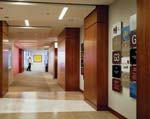 (Christopher Barrett/Hedrich Blessing) Jones Lang LaSalle Americas Headquarters: “neighborhoods” are linked by “information highways” and provide a consistent brand message.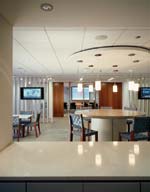 (Christopher Barrett/Hedrich Blessing) Teaming spaces and breakout areas were tripled.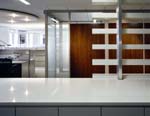 (Christopher Barrett/Hedrich Blessing) Architectural details, such as the ones seen in the coffee area here, mirror the neo-classical exterior of the AON skyscraper (Edward Durrell Stone/Perkins+Will, 1972).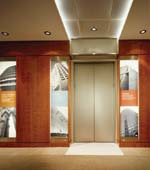 (Christopher Barrett/Hedrich Blessing) Elevator entryways welcome visitors in multiple languages, reinforcing Jones Lang LaSalle’s global brand.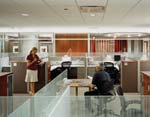 (Christopher Barrett/Hedrich Blessing) Cubicle walls have glass panel tops to open sightlines and spread natural light.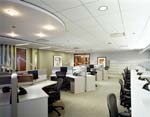 (Christopher Barrett/Hedrich Blessing) Visitor pods and workstations are used by hoteling employees.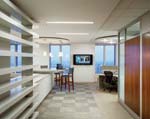 (Christopher Barrett/Hedrich Blessing) Impromptu breakout areas make last-minute meetings and chance encounters possible. (Christopher Barrett/Hedrich Blessing) The Pointe is a high-tech conference room used for internal training and client events; doors and panels along its adjacent wall open to the café and allow for increased capacity. (IA Interior Architects) Typical floor plan |
© 2007 ArchNewsNow.com